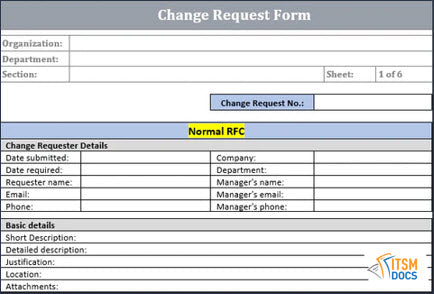Change Request Form | Fillable Change Request Template & Sample
Change Request Form
The change request form is the medium through which the change initiator can describe the proposed change's details.

Normal Request For Change
Important details to be captured in Normal Change tickets are:
RFC Number: a unique ID registered for the change
Change Description: the description of the change
Change Location: the location where the change will be implemented
Change Requester: the person who requested the change request/RFC
Change Analyst: the name of the change analyst who will analyze the change request/RFC
Change Requested Date: the date on which the change was requested.
Change Triggered By: defines the sources that triggered the change like legal requirements, business requirements, etc.
Change Classification: the classification of the change like Normal, Standard, and Emergency
Category: the category of the change
Type: the type of change
Item: item of the change
Assignment group: The group assigned to own and possibly implement the Change Request
Risk analysis: describes the risks associated with the change.
Business Case: the plan which defines the business justification, benefits, and resources needed
Rollback Plan: the description of the rollback plan
Risk analysis: the description of the risk analysis
Remediation Plan: the description of the remediation plan
Impacting Services: the services that the change will impact
Impacting CIs: the CIs that the change will impact
Relative Benefit of Implementing the Change: the benefit of implementing change
Relative Cost: This should define the relative costs
Estimated Effort in Man Days or Hours: Man days or hours
Change Approval/Rejected Date: the date and time when the change was approved/ rejected by
CAB
CAB Decision: a decision made by the CAB
CAB Comments: comments given by the CAB
ECAB Decision: decision made by the ECAB
ECAB comments: comments given by the ECAB
Change Manager: name of the change manager
Impact: The number of people that will be affected by the change
Urgency: how soon the change has to be implemented
Priority: It will be based on impact and urgency
SLAs Associated: SLAs associated with change management
SLA Target Date and Time: date and time when the SLAs will be breached concerning the change
Major Change Review: This determines if it's a major change
Primary Change Justification: This defines the business justification and why it should be treated as a major change
Associated Incidents: the details of the incident tickets that are associated with this change
Associated Problems: the details of the problem tickets that are associated with this change
SLAs Breach Details: the description of why the SLAs were breached and by how many minutes or hours did we breach the SLAs.
PIR: defines the lessons learned.
Emergency RFC

Important details to be captured in Emergency Change tickets are:
RFC Number: a unique ID registered for the change
Change Description: the description of the change
Change Location: the location where the change will be implemented
Change Requester: the person who requested the change request/RFC
Change Analyst: the name of the change analyst who will analyze the change request/RFC
Change Requested Date: the date on which the change was requested.
Change Triggered By: defines the sources that triggered the change like legal requirements, business requirements, etc.
Change Classification: the classification of the change like Normal, Standard, and Emergency
Category: the category of the change
Type: the type of change
Item: item of the change
Risk analysis: describes the risks associated with the change.
Business Case: the plan which defines the business justification, benefits, and resources needed
Rollback Plan: the description of the rollback plan
Risk analysis: the description of the risk analysis
Remediation Plan: the description of the remediation plan
Impacting Services: the services that the change will impact
Impacting CIs: the CIs that the change will impact
Change Approval/Rejected Date: the date and time when the change was approved/ rejected by
CAB
ECAB comments: comments given by the ECAB
Change Manager: name of the change manager
Impact: The number of people that will be affected by the change
Urgency: how soon the change has to be implemented
Priority: It will be based on impact and urgency
SLAs Associated: SLAs associated with change management
SLA Target Date and Time: date and time when the SLAs will be breached concerning the change
Associated Incidents: the details of the incident tickets that are associated with this change
Associated Problems: the details of the problem tickets that are associated with this change
SLAs Breach Details: the description of why the SLAs were breached and by how many minutes or hours did we breach the SLAs.
PIR: defines the lessons learned



